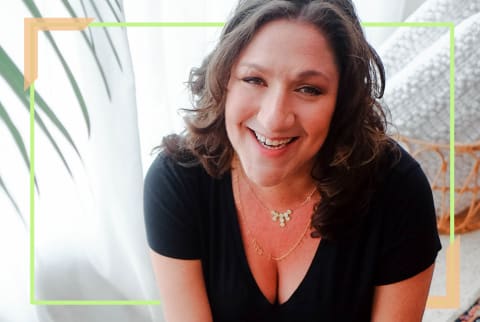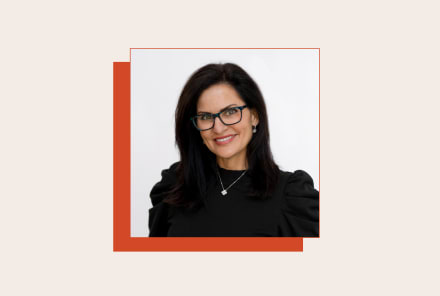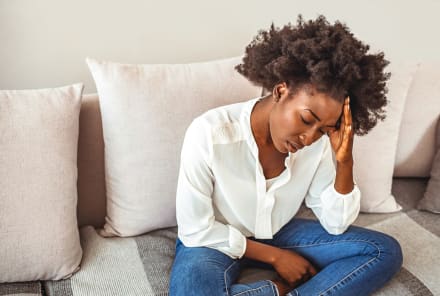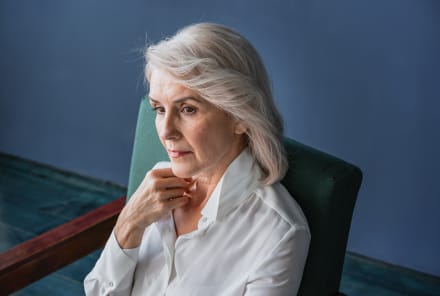Advertisement
I Was Diagnosed With A Rare Syndrome At Age 10: Here's How I've Learned To Own It As An Adult


During my childhood, my mom took me to see every doctor, dermatologist, healer, dietitian, and nutritionist she could find. No one had answers as to why I was dealing with fungal infections and skin issues such as eczema, rosacea, and boils.
I was 10 years old when I received my diagnosis.
At age 10, my mom took me to an immunologist who did a blood test and finally had a diagnosis for me: Job Syndrome (Hyper-IgE syndrome)1, a rare, primary immunodeficiency, which is distinguished by atopic dermatitis, recurrent skin infections, and recurrent pulmonary infections.
She was immediately clear that it was so rare, she didn't have further information to share with me aside from the diagnosis. I don't know if she had any other patients who had the condition—it's unlikely since it affects one in a million people—but she knew what it was, and I was grateful for that.
The immunologist also informed me about a team of infectious disease doctors at the National Institutes of Health2 (NIH) who had been researching this condition, and she advised me to meet with them. However, after spending so many years of being poked and prodded, trying to get an answer, I really didn't care to be a guinea pig for research. It was really hard for me at that point in my life, as a preteen, to even think working with those doctors would benefit me, let alone might help other people. I just wanted to live my life, not have my health rule it and define me.
I tried to act like my illness didn't exist—until that became impossible.
Between the ages of 10 and 27, I dealt with some health issues here and there—but everything felt manageable. I didn't tell anyone about my illness. I was so secretive for so long with everyone in my life, except my parents. I didn't see it as part of my identity, and I suppressed the emotional side of navigating this illness for a really long time.
Then, when I was 27, everything changed. At the time, I was working a high-stress job in beauty PR. I remember strolling down the streets of Manhattan, and after walking two blocks, I felt like I was going to collapse. Quickly, that strange experience became a recurring problem. I'd have to get in a cab, pause on a street corner, or lean against the wall, unable to breathe normally. I lived in New York my whole life, I could walk 50 to 100 blocks and not flinch, and here I was only making it two blocks. It was terrifying.
I went to my general practitioner, who took an X-ray to see what was going on. First, she thought it was bronchitis, then pneumonia. She gave me some inhalers and antibiotics and sent me on my way. I didn't really think anything of it.
But after four months of this happening, without improvements, my mom insisted I see a specialist.
Walking down the street, it's important to realize you have no idea what people are dealing with.
I saw a pulmonologist who took an X-ray, CT scan, and blood work in one day. The results of the X-ray and blood work came back normal. But I knew there was something wrong. The following day the doctor called me and told me I had a cyst the size of a golf ball in my right lung, and I'd need to get it removed immediately.
I can still visualize where I was standing in my apartment; it was such a shock to my system. In that moment, it was so clear that my life was forever going to change—suppressing emotions and not dealing with my symptoms was no longer an option. There was no more hiding. I'd have to explain the surgery, and why I was on medical leave from my job, to the people in my life.
I called my former immunologist, whom I hadn't seen since I was a preteen, to get a second opinion. She told me, "If you have this surgery, you will not make it out alive." I was petrified and at a crossroads: One doctor said I needed to do it to stay alive; the other said I must not because I will die.
That's when I realized it was time to go to the National Institutes of Health, to meet with the infectious disease doctors. Fortunately, I was treated like a human, not the guinea pig I expected—they really cared about me, wanted to learn about me, and were eager to help. The doctors made it clear that although there were a lot of risks associated with the surgery, it was crucial.
I had the surgery—a lobectomy, where a quarter of my right lung was removed—on March 5, 2012. The recovery was intense: I couldn't walk well, I didn't have much energy, and I couldn't even open my window by myself. What they removed from my lung was something called aspergillus, which is a form of mold. I hoped that after my recovery, that would be the end of my pulmonary issues.
Unfortunately, that was not the case. A year and a half later, I was hospitalized with pneumonia. Ever since then, I've been in the regular care of the same pulmonologist who found the initial cyst, and the infectious disease department at the National Institutes of Health, who work really well together. I know a lot of people with an invisible illnesses say they are not taken seriously by doctors. Prior to my diagnosis when I was 10, I experienced that as well. But in recent years, when I needed the most support, I've been surrounded by people who genuinely care.
From that point, I knew my lifestyle had to change.
After my surgery, I realized I needed to shift my priorities. I was working a very high-stress job and was miserable. I'd been convinced that in order to move forward in life, I had to keep pushing through—but my body couldn't keep up with that pace anymore.
So I reworked my diet, I learned to meditate, and I discovered my limits—which I certainly hadn't done for the first 27 years of my life.
The next stage of my journey was starting a business and becoming my own boss, which made it possible to manage my health and life in a way that works for me. Now, I don't take any calls on Mondays or Fridays, and I don't book anything before noon. Those boundaries allow me to prioritize my well-being—for my physical and mental health. I'm able to choose how I use my time—whether it's getting acupuncture, practicing yoga, going for a long walk, seeing friends, sleeping in, or whatever my body needs.
Being aware of what I'm physically, emotionally, and mentally capable of handling is crucial—then vocalizing it, and staying firm. All of my friends and clients know my boundaries and are typically very good at honoring them.
It was challenging, but I started opening up about my condition.
The surgery shifted more than just my lifestyle. After years of hiding my condition from my friends, I began disclosing the underlying reason I needed to have this surgery, and why it was so risky.
Over the years, I've found it can feel like a burden to report to loved ones what I'm going through, as I'm going through it. One big challenge for me is that I'm really good at giving the facts—but I'm not very good at saying how I'm feeling. That's why I appreciate it when my friends check in on me, even if I don't respond or engage. It's important to have ongoing conversations with loved ones, so when something challenging comes up, they pick up on it—since they know you in the good times and the bad.
I've also become a huge believer in therapy because I definitely say things to my therapist that I haven't said to anyone else. Working with her has gotten me expressing feelings I didn't think I'd ever say out loud.
Since it is hard for me to vocalize what I'm going through, writing has become a powerful tool. It's a place to get my thoughts on paper—whether that's through journaling, publishing my work, or being in a writing class. I'm very open to sharing my story to educate and hopefully help other people going through similar experiences with invisible illness.
As I began to own and share my own story, I recognized that there wasn't a hub that allowed people with invisible illnesses to share their stories. That's why I started the podcast Made Visible, to share stories of people living with or affected by invisible illness. My guests included patients as well as caregivers, doctors, healers, family members, and people who started businesses in the invisible illness space. After releasing 100 episodes, I started facilitating writing classes to help people write, process, and publish their stories about invisible illness.
What I want people to know about living with Job Syndrome.
Bottom line: Managing a rare illness is exhausting. In fact, exhaustion and fatigue are the most dominant feelings I experience—more than anger or frustration.
One big challenge is, because there are so few people in the world diagnosed with my condition, there's not a lot of information on how to treat the syndrome. It's constantly changing and evolving—which means I'm regularly dealing with reactions to new treatments and then managing them with my medical team.
Some of the hardest aspects for me are the physical challenges—it's tough to walk up stairs or walk uphill. I have limits, and sometimes I push it too far instead of expressing to whoever I'm with when I need a break or can't talk while I'm going uphill. I don't want to feel different in those moments; I want to be able to do the things my friends are doing.
When I go to a concert for one of my favorite bands, I'd love to dance like wild, but I'm exhausted pretty fast—and that destroys me. Still, I have to listen to my body in those moments. I know when pushing it is acceptable, and when it is not.
There's also the invisible aspect of this illness—people often don't know how to help you if they can't see what's physically happening to you. Walking down the street, it's important to realize you have no idea what people are dealing with. Just because I don't express my emotions doesn't mean I don't have them. Just because you can't see my lung doesn't mean there wasn't a golf-ball-size growth in there. It's all about approaching people with compassion.
My advice on advocating for your health.
As I've had more conversations with people in the invisible illness community, I've discovered one very important thing is acknowledging your time is equally valuable to your doctor's time. A lot of people go into situations with doctors and specialists who are very well regarded—so if they can get five minutes in their office, they'll take it. But it's imperative to make sure your voice is heard and your issues are met.
I always recommend coming in with a list of questions written out so you don't have to think about it in a potentially high-stress or rushed moment. Ultimately, it's essential to say what your needs are, and make sure you're on the same page with the doctor.
Now, I accept myself exactly as I am.
I believe you are so much more than your health, no matter what you're dealing with. In my younger years, I wanted to fit in, and I had so much shame around feeling and looking different. But now as an adult, I'm thrilled that I'm not typical. In fact, I think that's what makes me special—I'm able to identify that I have my health stuff, and yeah, it's weird. But I own it. When doctors see me for the first time and say, "Well I've never seen this before," I'm not rattled anymore.
Yes, of course, I think. That's because I'm one in a million—I'm actually one in a million.
Watch Next
Enjoy some of our favorite clips from classes
Enjoy some of our favorite clips from classes
What Is Meditation?
Mindfulness/Spirituality | Light Watkins
Box Breathing
Mindfulness/Spirituality | Gwen Dittmar
What Breathwork Can Address
Mindfulness/Spirituality | Gwen Dittmar
The 8 Limbs of Yoga - What is Asana?
Yoga | Caley Alyssa
Two Standing Postures to Open Up Tight Hips
Yoga | Caley Alyssa
How Plants Can Optimize Athletic Performance
Nutrition | Rich Roll
What to Eat Before a Workout
Nutrition | Rich Roll
How Ayurveda Helps Us Navigate Modern Life
Nutrition | Sahara Rose
Messages About Love & Relationships
Love & Relationships | Esther Perel
Love Languages
Love & Relationships | Esther Perel
What Is Meditation?
Box Breathing
What Breathwork Can Address
The 8 Limbs of Yoga - What is Asana?
Two Standing Postures to Open Up Tight Hips
How Plants Can Optimize Athletic Performance
What to Eat Before a Workout
How Ayurveda Helps Us Navigate Modern Life
Messages About Love & Relationships
Love Languages
Advertisement

This Little-Known Supplement Helps Women Sleep & Decreases Signs Of Depression
Molly Knudsen, M.S., RDN

This Little-Known Supplement Helps Women Sleep & Decreases Signs Of Depression
Molly Knudsen, M.S., RDN















